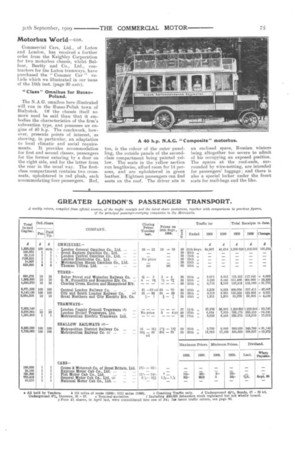Motorbus World.
Page 8

Page 9

If you've noticed an error in this article please click here to report it so we can fix it.
News contributions are invited Payment will be made on publication• The first and third pages of this issue deal further with an important matter which affects every London motorbus company, viz., the laying of asphalt with modified angles of camber and side-fall.
Sir MeIvill Beachcroft, Chairman of the London County Council, in opening the eighth annual Conference of the Municipal Tramways Association last, week, expressed the view that London, in spite of its huge area, had the best local traffic arrangements in the world, inclusive of tube and underground railways, omnibus a-nd cab facilities, and electric tramcars.
The Barking Ratepayers' Association thinks that the speed of motorbuses should be restricted to 10 through the town, and has endeavoured to initiate steps to secure an order to that effect. It was decided. after discussion, to rest content with the addressing of a letter, to the motorbus companies concerned, asking that the speed should be modified.
The Right to Go Fast.
Judge Rentotil, in the City of London Court, on the 22nd inst., in entering judgment for the London General Omnibus Co., Ltd., in respect of a claim by a Mr. Woolf Levy, for £100 for personal injuries, maae the following noteworthy comment: " He supposed motor omnibuses had now established a right by custom to go a little faster than some of them liked, Even motor-omnibus proprietors had rights. His sympathies were entirely with the plaintiff, who had been seriously hurt." The plaintiff had been knocked down, through his suddenly stopping in front of one of defendant company's motorbuses in New Broad Street.
Railway Enterprise.
The Great Western Railway Company has led the way, of all railway and luggage are now collected from Liverpool hotels, or at other places of call, conveyed across the Mersey, and taken right alongside the train at the Birkenhead terminus of the line— conveniences whose cost should be more than recouped to the company.
A Tramway-Man's Forecast.
Mr. A. L. C. Fell, the Chief Officer of the London County Council tramways, has predicted that motorbuses will be exhibited as curios in museums 20 years hence. This was at a conference of tramway men, and it no doubt fell upon sympathetic ears, but we think Mr. Fell must be peculiarly unobservant of contemporary happenings to give utterance to such a statement in public.
Ashbourne-Derby.
The service inaugurated by Commercial Car Hirers, Ltd., of Cambridge Circus, W.C., in consequence of notices which appeared in this journal, continues to meet with good patronage, and is likely to he established on a permanent basis. The " Commer Car " vehicle now used is largely supported by people who go to market in Derby with egg.s and butter, whilst private customers are growing in number. Now that motor services are at least as reliable as railway services, it is no surprise to us that this popularity should have been achieved.
Commercial Cars, Ltd., of Luton and London, has received a further order from the Keighiey Corporation for two motorbus chassis, whilst Balfour, Beatty and Co., Ltd., contractors for the Luton tramways, have purchased the " Coutmer Car " vehicle which we illustrated in our issue of the 16th inst. (page 30 ante).
"Class" Omnibus Tor RussoPoland.
The N.A.G. omnibus here illustrated will run in the Russo-Polish town of Bialystok. Of the chassis itself no more need be said than that it embodies the characteristics of the firm's subvention type, and possesses an engine of 40 h.p. The coachwork, however, presents points of interest, as showing, in particular, an adaptation to local climatic and social require, rnents. It provides accommodation for first and second classes, passengers for the former entering by a door on the right side, and for the 'latter from the rear in the usual way. The firstclass compartment contains two crossseats, upholstered in red plush, each accommodating four passengers. Red,
too, is the colour of the outer panelling, the outside panels of the secondclass compartment being painted yellow. The seats in the yellow section run lengthwise, afford room for 14 persons, and are upholstered in green leather. Eighteen passengers can find seats on the roof. The driver sits in an enclosed space, Russian winters being altogether too severe to admit of his occupying an exposed position. The spaces at the roof-ends, surrounded by wire-netting, are intended for passengers' luggage ; and there is also a special locker under the front scats for mail-bags and the like.






















